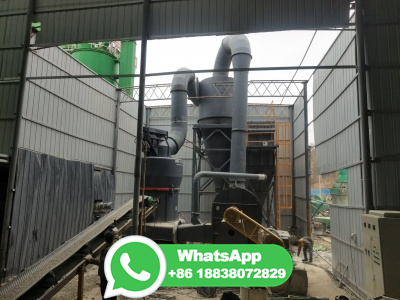
The uranium fuel cycle as defined by the AEA begins at the uranium mill, after the uranium is removed from its place in nature. Because laws do not classify mine overburden or waste rock under the AEA as low level radioactive waste or uranium byproduct material, its placement in specialized radioactive waste disposal facilities is not ...
WhatsApp: +86 18838072829
Three Product Formula. When a process produces three output streams such as an additional middling or second concentrate stream, then the mineral or metal distribution can be calculated using the same principle as that of the two product formula. ... Mining and milling of uranium. I. HoreLacy, in Nuclear Fuel Cycle Science and ...
WhatsApp: +86 18838072829
The mention of names of specific companies or products (whether or not indicated as registered) does not imply any intention to infringe proprietary rights, nor should it be ... Applications in uranium milling 145 General circuit descriptions 145 Solidliquid separation equipment 149 ... Influence of die process 265 Site ...
WhatsApp: +86 18838072829
Uranium mill tailings are of particular environmental concern because: (a) They retain much of the radioactivity of the ore from which they were derived; (b) Their radioactivity is very long lived; (c) They contain a range of biotoxic heavy metals and other compounds; (d) They may contain sulphide minerals which can generate acid mine drainage;
WhatsApp: +86 18838072829
Uranium milling is a series of mechanical and chemical processes that process extracted uranium ore and produces dry powderform material consisting of natural uranium called " yellowcake " (chemically U 3 O 8) because of its yellowish color.
WhatsApp: +86 18838072829
Many of the findings related to occupational exposures and adverse health outcomes presented in this chapter are based on studies of uranium and hardrock miners (, workerbased radon studies) for periods of disease risk when the magnitude of the exposures was much greater than the exposures reported at most mines and processing facilities in North America today. Nevertheless, although ...
WhatsApp: +86 18838072829
The nuclear fuel supply chain begins with mining and milling uranium ore. But it is the chemical process of converting the ore into uranium hexafluoride gas and then enriching the uranium235 ...
WhatsApp: +86 18838072829
Nuclear reactor Uranium Mining, Processing: Uranium is extracted from ores whose uranium content is often less than percent (one part per thousand). Most ore deposits occur at or near the surface; whether they are mined through openpit or underground techniques depends on the depth of the deposit and its slope. The mined ore is crushed and the uranium chemically extracted from it at the ...
WhatsApp: +86 18838072829
The White Mesa Mill is the only conventional uranium mill operating in the US today, has a licensed capacity of over 8 million pounds of U 3 O 8 per year, and has the ability to produce vanadium ...
WhatsApp: +86 18838072829
The basis of the process is the formation of the stable 'uranyl tricarbonate1 complex ion, in which form the uranium passes into solution. To be able to dissolve in carbonate solution, the uranium must be present in the hexavalent (uranyl) state and it is. necessary, therefore, first to oxidise tetravalent (uranous) minerals.
WhatsApp: +86 18838072829
Conventional mines have a mill where the ore is crushed, ground and then leached with sulfuric acid to dissolve the uranium oxides. At the mill of a conventional mine, or the treatment plant of an ISL operation, the uranium then separated by ion exchange before being dried and packed, usually as U 3 O mills and ISL operations (especially in the USA) use carbonate leaching instead of ...
WhatsApp: +86 18838072829
After uranium ore is removed from the ground, it must be processed to extract the contained uranium. This process, "milling," involves a sequence of physical and chemical treatment steps to extract the uranium from the native rock. The final product of milling is yellowcake or U 3 O 8, which is the commercial product sold by uranium ...
WhatsApp: +86 18838072829
A conventional uranium mill is a chemical plant that extracts uranium using the following process: Trucks deliver uranium ore to the mill, where it is crushed into smaller particles before being extracted (or leached). In most cases, sulfuric acid is the leaching agent, but alkaline solutions can also be used to leach the uranium from the ore.
WhatsApp: +86 18838072829
Ripios has many properties in common with uranium mill tailings: like in tailings, the uranium isotopes U238 and U235 are no longer in secular equilibrium with their respective decay products. Due to the poorer uranium recovery of the heap leaching process, the fraction of residual uranium remaining in ripios is higher than in tailings, though.
WhatsApp: +86 18838072829
Uranium milling is the process of extracting and purifying uranium ore concentrates (UOC) from uraniumrich geological deposits. On the order of 62,071 tons of uranium were produced worldwide in 2016 by commercial U mills; Kazakhstan's and Canada's production combined to account for over 62% of the total annual production ( Grancea et al., 2018 ).
WhatsApp: +86 18838072829
Uranium mill tailings contain the radioactive element radium, which decays to produce the radioactive gas radon. Most uranium mill tailings are placed near the processing facility, or mill, where they come from. Uranium mill tailings are covered with a sealing barrier of material such as clay to prevent radon from escaping into the atmosphere.
WhatsApp: +86 18838072829
USbased critical minerals company Energy Fuels is preparing four of its convention uranium mines production, CEO Mark Chalmers reported on Friday. Together, these mines have the ability to ...
WhatsApp: +86 18838072829
The nuclear fuel cycle is an industrial process involving various activities to produce electricity from uranium in nuclear power reactors. Exploration for uranium is followed by mining and milling of the raw uranium ore. Raw uranium must then be processed, including through enrichment, in order to maximise its efficiency as fuel.
WhatsApp: +86 18838072829
Ores that contain uranium, thorium, or any combination thereof, at onetwentieth of one percent ( percent) or more by weight are source material. Where does source material come from? Source material includes most uranium and thorium ores and product resulting from the mining and milling processes.
WhatsApp: +86 18838072829
Depleted uranium has a lower specific radioactivity per mass than natural uranium because the enrichment process reduces the percentage of other isotopes, U234 and U235. The specific radioactivity of the storage containers increases over time as the daughter products, removed during uranium recovery and conversion processes, return to ...
WhatsApp: +86 18838072829
On this page: What We Regulate; How We Regulate; What We Regulate. The nuclear fuel cycle is the process of removing uranium from the ground, converting it into nuclear fuel for use in commercial power reactors, and managing its storage and ultimate disposal as waste. Uranium recovery is the first step removing uranium from the Earth and milling it to produce a product called "yellowcake ...
WhatsApp: +86 18838072829
It is this process, in effect 'burning' uranium, which occurs in a nuclear reactor. The heat is used to make steam to produce electricity. Examples of nuclear fissioning of uranium235. ... The end product of the mining and milling stages, or of ISL, is uranium oxide concentrate (U 3 O 8). This is the form in which uranium is sold.
WhatsApp: +86 18838072829
Uranium mining is the first step in the generation of both nuclear power and nuclear weapons. Nuclear power plants produce routine radioactive emissions in air and water, produce nuclear waste, and create conditions for disasters similar to Chernobyl and Fukushima. Physicians should be concerned about the health effects of the uranium continuum.
WhatsApp: +86 18838072829
A final roasting or drying operation produced the refined material as either black oxide or soda salt. The different uranium mining facilities produced different grades and forms of uranium, and, as such, required slightly different milling processes.
WhatsApp: +86 18838072829
Unquestionably the biggest impact of underground uranium mining on human health was due to radon inhalation (Brugge and Buchner, 2011). The radon isotope radon222 is an intermediate product in the decay chain of uranium238 and decays by alpha emission with a halflife of d. Because it is an inert gas, radon is nonreactive.
WhatsApp: +86 18838072829
The tailings or wastes produced by the extraction or concentration of uranium or thorium from any ore processed primarily for its source material content. as determined by the Nuclear Regulatory Commission, including mills, insitu recovery insitu recoveryA process to recover uranium in which fluids are injected into ground water to ...
WhatsApp: +86 18838072829
Uranium Milling and the Associated Chemistry. The ore is first crushed and then mixed with water so it can move through the milling system in a more liquid form. The ore is then exposed to acid in order to separate the uranium from other minerals in the ore. The uranium is now part of a liquid solution, which is separated from the other ...
WhatsApp: +86 18838072829
Open pit mining Inplace (insitu) solution mining Heap leaching Before 1980, most uranium was produced using open pit and underground mining techniques. Today, most uranium is produced using a solution mining technique commonly called insituleach (ISL) or insiturecovery (ISR) mining.
WhatsApp: +86 18838072829
The production of fuel for nuclear power plants starts with taking uranium ore from the ground and then purifying and processing it through a series of steps. Uranium recovery focuses on extracting natural uranium ore from the earth and concentrating (or milling) that ore. These recovery operations produce a product, called "yellowcake," which ...
WhatsApp: +86 18838072829
In the milling process, uranium is extracted from the crushed and groundup ore by leaching, in which either a strong acid or a strong alkaline solution is used to dissolve the uranium oxide. The uranium oxide is then precipitated and removed from the solution. After drying and usually heating, it is packed in drums as a concentrate.
WhatsApp: +86 18838072829
The uranium oxide product of a uranium mill is not directly usable as fuel for a nuclear reactor additional processing is required. Only % of natural uranium is 'fissile', or capable of undergoing fission, the process by which energy is produced in a nuclear reactor. ... The uranium enrichment process leads to the production of much ...
WhatsApp: +86 18838072829
Natural uranium consists primarily of two isotopes, uranium238 (238 U) and uranium235 (235 U), comprising % and %, respectively (Barré, 2010). The fissile 235 U can be forced to undergo a chain reaction and split ( fission) and release energy in the process. In a weapon, the release of energy is uncontrolled and leads to a ...
WhatsApp: +86 18838072829
Uranium milling is the process of converting mined uranium ore to uranium concentrate, also known as yellowcake uranium. 1 Milling is common to a number of mineral extraction industries and refers to the physical and chemical processes necessary to concentrate minerals from mined
WhatsApp: +86 18838072829
Focussing on the mining of uranium and its subsequent milling and refining operations, this chapter presents a highly critical review of the few known and many unknown effects of the nuclear industry upon the environment and the health of humans. ... One of the decay products, radon, is a gas considered responsible for 20% of the lung cancers ...
WhatsApp: +86 18838072829